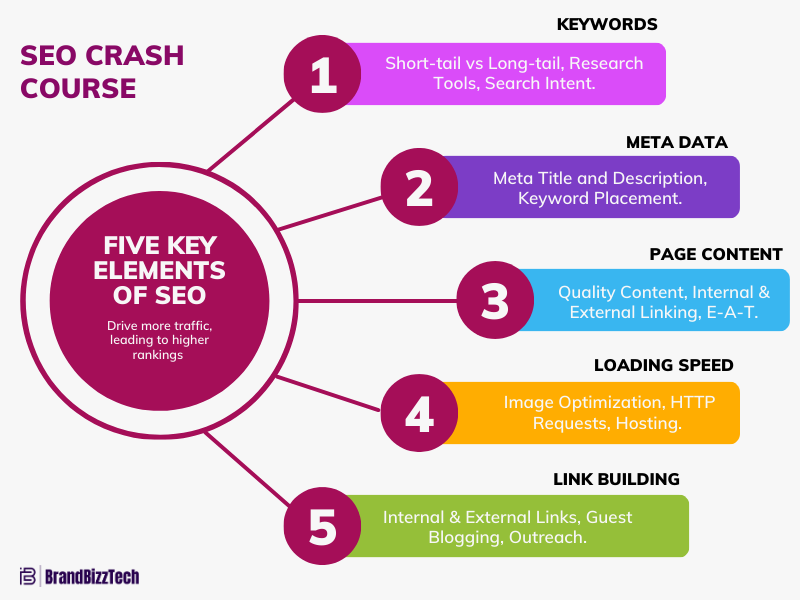SEO (Search Engine Optimization) is a critical factor in making your website more visible and increasing its chances of ranking higher in search engine results. There are five main pillars of SEO that every website owner must focus on: Keywords, Metadata, Page Content, Loading Speed, and Link Building. Let’s break these down to help you better understand how each element contributes to optimizing your site.
Table of Contents
Toggle1. Keywords: The Heart of SEO
Keywords are the words or phrases that users type into search engines when looking for information, services, or products. They are the cornerstone of SEO because they help search engines understand the main topic of your content, allowing your site to appear in relevant search results.
Types of Keywords:
Short-Tail Keywords:
Broad and general terms like “shoes” or “laptops,” which have high search volumes but also fierce competition.
Long-Tail Keywords:
More specific phrases like “best running shoes for flat feet” that have lower search volume but attract more targeted traffic and often result in better conversions.
Understanding Search Intent
What are users hoping to find? Search intents can be informational (e.g., “how to make chai”), transactional (e.g., “buy Nike shoes”), or navigational (e.g., “YouTube”).
Use Research Tools: Tools like Google Keyword Planner, SEMrush, and Moz help discover keywords by showing search volume, competition, and trends.
Competitor Analysis
Check the keywords your competitors rank for, and identify content gaps to improve your strategy.
Pro Tip: Avoid keyword stuffing—overloading your content with too many keywords can hurt readability and get your site penalized by search engines.
2. Metadata
Enhancing Search Engine Visibility: Metadata is the information that describes your webpage to search engines. This includes the meta title and meta description, which appear in search engine result pages (SERPs) and help users decide whether to click on your link.
Meta Title
This should be concise (under 60 characters) and keyword-optimized to accurately represent the page content.
Meta Description
A short snippet (below 160 characters) that provides a clear summary of your page. Although it doesn’t directly impact ranking, a well-crafted meta description increases click-through rates.
Best Practices
Include your primary keywords naturally.
Write clear, engaging titles and descriptions that attract users to click.
3. Page Content
Quality Over Quantity
Content is the core of any SEO strategy. It’s important to produce informative, relevant, and valuable content that answers user queries or solves their problems. High-quality, in-depth content generally ranks better than short or superficial articles.
Keywords in Content
Naturally place your keywords in key areas like titles, headings, body text, and image alt tags, but avoid overdoing it.
Internal & External Linking
Connect your pages through internal links to help search engines navigate your site. External links to credible sources can build trust and improve content quality.
E-A-T (Expertise, Authoritativeness, Trustworthiness)
Google rewards content from reliable, authoritative sources, so make sure your content reflects expertise.
4. Loading Speed: A Key to Better Rankings
A website’s loading speed is crucial for both SEO and user experience. Google favors fast-loading websites because they enhance the user experience. Slow-loading pages, on the other hand, increase bounce rates, hurting your rankings and conversions.
Tips to Improve Loading Speed:
- Optimize Images: Compress and resize images without compromising quality.
- Reduce HTTP Requests: Limit the number of elements (scripts, stylesheets) that need to load.
- Use Reliable Hosting: A good hosting provider ensures faster server responses
5. Link Building: Building Authority for Your Site
Link building is the practice of getting other websites to link back to your site. These backlinks serve as votes of confidence, indicating to search engines that your content is credible and worth ranking higher.
Types of Links:
Internal Links
Links that connect different pages on your site, helping search engines understand the structure.
External Links (Backlinks)
Links from other websites to yours, which signal your content’s value and trustworthiness.
Ways to Build Links:
- Create High-Quality Content: Great content naturally attracts links.
- Guest Blogging: Write for other sites with a link back to your own.
- Outreach: Contact relevant websites to ask for backlinks.
- Final Thoughts: User Experience and Mobile Optimization
While the five fundamentals we’ve covered are essential for SEO, don’t forget that user experience and mobile optimization also play a key role. Websites that load quickly, are easy to navigate, and are mobile-friendly tend to perform better in search rankings. Google’s mobile-first indexing prioritizes the mobile version of your site, so make sure your website is optimized for smartphones.
By mastering these five key elements of SEO, you can effectively optimize your website for search engines and drive more traffic, leading to higher rankings and business growth.


